Beyond the ghosts and reeking mires
Dartmoor
by Sarah Shuckburgh
Sarah Shuckburgh is enchanted
by the silence, the unpolluted air and the wild, open
moorland of Dartmoor.
 Bluebells
carpet the moorland hollow, a purple-blue haze shimmering in
the dappled sunshine. From gnarled oaks, delicate wisps of
yellow lichen dangle – a sure sign that Dartmoor air is
unpolluted. Moss covers the ancient stone walls of a farm
building, long abandoned. Through the trees, I glimpse a
craggy skyline beneath a pale blue sky. It is utterly
silent. Bluebells
carpet the moorland hollow, a purple-blue haze shimmering in
the dappled sunshine. From gnarled oaks, delicate wisps of
yellow lichen dangle – a sure sign that Dartmoor air is
unpolluted. Moss covers the ancient stone walls of a farm
building, long abandoned. Through the trees, I glimpse a
craggy skyline beneath a pale blue sky. It is utterly
silent.
I had expected a bleak, forbidding place - a sinister
landscape of jagged peaks, barren moorland and dangerous
bogs, lashed by wind and rain. In Sir Arthur Conan Doyle’s
chilling tale of The Hound of the Baskervilles, Dartmoor
provides a mean and melancholy setting - ‘so vast, so barren
and so mysterious’. A giant fire-spitting hound terrorises
generations of Baskerville baronets who venture alone on the
moor. Conan Doyle’s trees are stunted and nipped, and dense
swirling fog conceals the convicted murderer, escaped from
the high security prison at Princetown. Even the pragmatic
Dr Watson finds the bald moor a ‘most God-forsaken corner of
the world’.
But my friend Jane and I find a benign and beautiful
landscape, bathed in spring sunshine.
We are staying at Holne Chase in the lush valley of the
river Dart on the eastern edge of Dartmoor. On our first
afternoon we walk along the bank of the shallow,
glassily-clear river as it rushes over rounded granite
boulders. Keen fishermen need go no further – the Dart is
famous for its wild brown trout, sea trout and salmon, and
Holne Chase provides ghillies on its private
8-mile stretch of the river. That evening, we dine on local
fish and on other delicious ‘slow food’ dishes, made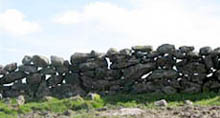 with
ingredients which have travelled an average of only nine
miles. with
ingredients which have travelled an average of only nine
miles.
The next morning, we navigate narrow winding lanes, between
dry stone walls, and stride over the open moor, through
heather, gorse and bracken towards Haytor. From the top, the
sense of space and emptiness is startling. The moor
stretches in all directions, wild and beautiful, an
undulating patchwork of grey, olive and russet. Buzzards
wheel overhead, mewing plaintively. Skylarks sing, and we
search for their tiny forms in the vast sky.
 Haytor granite quarry has been closed for 150 years, but
unique granite tram-tracks survive, on which teams of up to
18 horses dragged the quarried stone, some of it destined
for London to build St Paul’s cathedral and London Bridge.
Scrambling over steep slopes sprinkled with sparkling
granite clitter, we stumble, just as Sherlock Holmes did,
upon deserted gullies and flooded pits - the remains of
medieval tin mines, stannaries worked until the 1930s. Haytor granite quarry has been closed for 150 years, but
unique granite tram-tracks survive, on which teams of up to
18 horses dragged the quarried stone, some of it destined
for London to build St Paul’s cathedral and London Bridge.
Scrambling over steep slopes sprinkled with sparkling
granite clitter, we stumble, just as Sherlock Holmes did,
upon deserted gullies and flooded pits - the remains of
medieval tin mines, stannaries worked until the 1930s.
Few
people live on Dartmoor today, but everywhere there are
signs of previous occupants. Sherlock Holmes sheltered in a
Neolithic hut while spying out the Baskerville hound – and
there are indeed thousands of Bronze Age stone circles and
rows, burial chambers, enclosures, cairns and standing
stones on Dartmoor, evidence that this area was inhabited
from 2500 BC. The settlements were abandoned about two
thousand years later, when the climate changed, becoming too
cold to grow crops at this altitude.

The moor was farmed again in the 13th century, and many
villages today have medieval foundations. The characteristic
Dartmoor longhouses were single-storey, thatched buildings
where farmers and their animals lived under one roof, with
the floor sloping down towards the ‘shippon’, the cattle
end. We find our way to the fascinating ruins of Houndtor
hamlet, abandoned in the 15th century and only rediscovered
by archaeologists 50 years ago. The walls and roof of
wattle, turf and heather have collapsed, but low
grass-topped foundations of stone and shingle ‘growan’
reveal that 800 years ago the hamlet contained four
traditional longhouses, four smaller dwellings and three
granaries with kilns to dry corn during Dartmoor’s cold wet
summers. In the longhouses, fireplaces and ovens
are still visible, with north-facing alcoves which were
perhaps cool larders. Around the hamlet, archaeologists have
found evidence of paddocks enclosed with stone corn ditches,
and of gardens, lanes, ‘arish’ fields of ridge and furrow,
and strip farming on narrow terraced lynchets. Medieval
farmers burned bracken to encourage the growth of grass on
this arid land – and the practice of swaling continues to
this day.
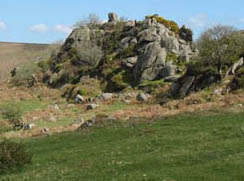 Locals
claim that Conan Doyle was inspired to write his Baskerville
tale by Houndtor’s jagged summit which, with a stretch of
the imagination, resembles a pack of hounds, frozen in
mid-flight. Jane and I hike over the rough grass and rest
beneath a granite crag. We are not alone - five excited
children and their impressively agile parents are scrambling
over the rocks, searching determinedly
among the boulders. We are witnessing the traditional sport
of letterboxing – a treasure hunt unique to Dartmoor. As we
watch, one of the children spots a mildewed Tupperware box
concealed among the crags, and triumphantly pulls out a
rubber stamp and a notebook. The family huddles round,
pressing the stamp into an ink pad and recording this
successful discovery, before putting stamp and notebook back
and hiding the box again among the rocks. Locals
claim that Conan Doyle was inspired to write his Baskerville
tale by Houndtor’s jagged summit which, with a stretch of
the imagination, resembles a pack of hounds, frozen in
mid-flight. Jane and I hike over the rough grass and rest
beneath a granite crag. We are not alone - five excited
children and their impressively agile parents are scrambling
over the rocks, searching determinedly
among the boulders. We are witnessing the traditional sport
of letterboxing – a treasure hunt unique to Dartmoor. As we
watch, one of the children spots a mildewed Tupperware box
concealed among the crags, and triumphantly pulls out a
rubber stamp and a notebook. The family huddles round,
pressing the stamp into an ink pad and recording this
successful discovery, before putting stamp and notebook back
and hiding the box again among the rocks.
We watch lazily as other energetic visitors cycle past us,
bumping and skidding over the tussocks. Some even hardier
types arrive, festooned with ropes and clanking cams and
carabiners, ready to scale a precipitous rock face. Serious
hikers stalk past in gaiters and boots, with maps in
protective plastic pouches. Dartmoor has been a national
park since 1951, but the recent Countryside and Rights of
Way Act came into effect here in the summer of 2005, giving
walkers increased rights to roam.
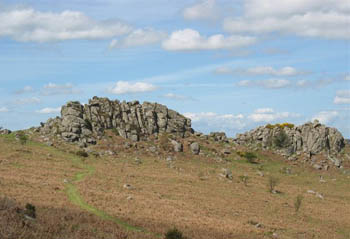
From our sunny vantage point, Dartmoor seems welcoming and
utterly wholesome, but Jane has been reading about ghosts,
piskies, witches, omens and other supernatural occurrences.
According to Jane, Dartmoor is the most haunted place in
Britain. In the pub at lunchtime, locals confirm in
matter-of-fact voices that the devil has dropped into
several Dartmoor inns. We hear about ghosts living in
Neolithic huts at Lustleigh Cleave, about a pair of
disembodied hairy hands which grip reins and steering
wheels, causing fatal accidents on the road between
Postbridge and Two Bridges, and about the little drummer
boy, who froze to death on the moor, and whose eerie
percussion has rung out on snowy nights since the Napoleonic
wars. Men’s screams and the neighing of wounded horses have
been heard at Chagford ever since a battle in 1643. And in
the pretty village of Widecombe-in-the-Moor, locals tell us
about Uncle Tom Cobley, who took his grey mare to
Widecombe’s autumn fair, with six people clinging to the
saddle. Cobley rode the horse to death, and its ghost haunts
the moor to this day.
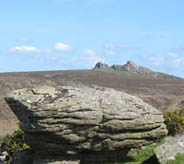 That night, we look out into the darkness and believe all
the stories. Even by day, there are perils on Dartmoor -
scattered over the moor are patches of bog -
innocent-looking with quivering grasses and rushes, but
deadly to unsuspecting wanderers. Conan Doyle describes moorland ponies
being sucked into the reeking mire, ‘rolling and tossing
among the green sedges’ before disappearing forever. Th That night, we look out into the darkness and believe all
the stories. Even by day, there are perils on Dartmoor -
scattered over the moor are patches of bog -
innocent-looking with quivering grasses and rushes, but
deadly to unsuspecting wanderers. Conan Doyle describes moorland ponies
being sucked into the reeking mire, ‘rolling and tossing
among the green sedges’ before disappearing forever. Th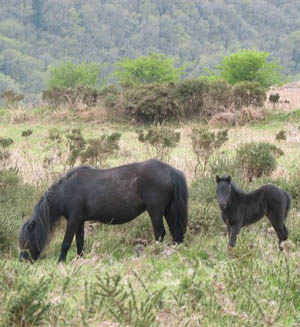 e
fiery Baskerville hound is tethered on an island in the
middle of an impenetrable mire, and later the Baskerville
villain himself disappears, presumed drowned in the ‘foul
slime of the huge morass’. e
fiery Baskerville hound is tethered on an island in the
middle of an impenetrable mire, and later the Baskerville
villain himself disappears, presumed drowned in the ‘foul
slime of the huge morass’.
Our final walk follows Dr Blackall’s Drive, a stony
carriageway carved high above the Dart valley by a local
doctor for his pleasure rides. Stocky Dartmoor ponies graze
nonchalantly as we stride by. We can hear the sound of
rushing water, far below in the wooded gorge. All around
stretches a jagged skyline of rocky summits – Bel Tor, Sharp
Tor, Mel Tor. We walk for several hours, and meet nobody.
Dartmoor is southern Britain’s largest area of wilderness -
a region of spectacular and contrasting landscapes, from
rugged open moorland with rocky tors and steep
boulder-strewn slopes, to gentle wooded combes, grassy downs
and rolling farmland, with leats and gorges. Read The Hound
of the Baskervilles before you visit, and go expecting the
‘vast gloom’ and ghostliness of Conan Doyle’s Dartmoor. The
reality will surprise and delight.
First published by the Telegraph
©SarahShuckburgh |